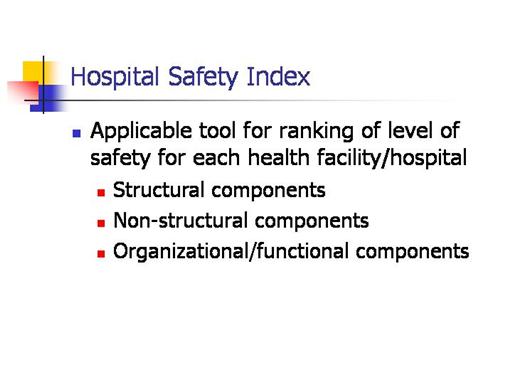| front |1 |2 |3 |4 |5 |6 |7 |8 |9 |10 |11 |12 |13 |14 |15 |16 |17 |18 |19 |20 |21 |22 |23 |24 |25 |review |
 |
One of essential questions in terms
of the safety hospitals is how can we determine whether the hospital is
safe or not.
The Disaster Mitigation Advisory
Group (DiMAG), a group of expert engineers, architects, health services
administrators and disaster specialists are working on development of
low-cost, easy-to-use indicators for estimations of hospitals’
safety. One of these indicators is called
“Hospital Safety Index”. This tool provides opportunity to rank the level of
safety, to prioritize
actions and to monitor the progress.
The Hospital Safety Index incorporate
general information on each facility’s level of complexity, the
population it serves, the number of health staff it has, natural hazards
prevalent in the area, and disaster history. The appropriate checklist
is used and questions is targeted
to understood as much as possible
about:
-structural components of the
hospitals (load bearing walls, foundations, columns, etc. and are
targeted to the design and integrity of the building to withstand
earthquakes, floods or other disasters
-non-structural components include
the safety of internal infrastructure, communication system, lifeline
facilities, water supply, emergency and fire suppression system,
laboratory services, architectural elements such as laboratory
equipment, furnishings, ventilation or electrical systems
- Functional elements for safety
include accessibility, policies, staff preparedness, and operational and
security systems.
Each component’s safety is ranked as
high, medium or low, following a series of pre-determined standards.
|